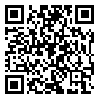Fri, Dec 26, 2025
| فارسی
Volume 29, Issue 2 (Summer 2023)
IJPCP 2023, 29(2): 188-201 |
Back to browse issues page
Download citation:
BibTeX | RIS | EndNote | Medlars | ProCite | Reference Manager | RefWorks
Send citation to:



BibTeX | RIS | EndNote | Medlars | ProCite | Reference Manager | RefWorks
Send citation to:
Kamalfar S, Mousavi R, Alinaghimaddah S M. Effect of Midazolam on the Incidence of Agitation in Patients Undergoing Electroconvulsive Therapy: A Randomized Clinical Trial. IJPCP 2023; 29 (2) :188-201
URL: http://ijpcp.iums.ac.ir/article-1-3878-en.html
URL: http://ijpcp.iums.ac.ir/article-1-3878-en.html
1- Development and Clinical Research Unit 5 Azar (DCRU), Golestan University of Medical Sciences, Gorgan, Iran.
2- Development and Clinical Research Unit 5 Azar (DCRU), Golestan University of Medical Sciences, Gorgan, Iran. ,mitramaddah2000@yahoo.com
2- Development and Clinical Research Unit 5 Azar (DCRU), Golestan University of Medical Sciences, Gorgan, Iran. ,
Abstract: (2552 Views)
Objectives Electroconvulsive therapy (ECT) is one of the treatment methods for neuropsychiatric patients. Midazolam is a relatively short-acting benzodiazepine drug used as a pre-anesthetic drug and has sedative, anticonvulsant, and muscle relaxant effects. This study aims to investigate the effect of midazolam on agitation in patients undergoing ECT.
Methods This double-blinded clinical trial was conducted on 80 patients (aged 18-75 years) diagnosed with psychotic disorders indicating the need for ECT. The patients were selected by a convenience sampling method and allocated to two placebo and intervention groups by the envelope method. In the control group, the patients were injected with 2cc of distilled water, 2 mg/kg nesdonal, 0.5 mg/kg atropine, and 0.5 mg/kg succinylcholine. In the intervention group, in addition to these drugs, 0.2 mg/kg midazolam was injected at 4 sessions. The Richmond agitation sedation scale (RASS) was used to assess agitation immediately and one hour after ECT. Data were analyzed in SPSS software, version using independent t-test, Man-Whitney U test, and chi square test. The significance level was set at 0.05.
Results The data of 42 patients in the intervention group and 38 in the control group were analyzed. The mean systolic and diastolic blood pressures were significantly lower in the intervention group. Immediately after ECT, 68% and 44% of patients in the intervention and control groups, respectively, were alert and calm. The patients in the midazolam group had a better condition based on the RASS score one hour after ECT (P=0.04).
Conclusion Midazolam is able to reduce agitation in patients receiving ECT and can control the changes in systolic and diastolic blood pressures in the long term.
Methods This double-blinded clinical trial was conducted on 80 patients (aged 18-75 years) diagnosed with psychotic disorders indicating the need for ECT. The patients were selected by a convenience sampling method and allocated to two placebo and intervention groups by the envelope method. In the control group, the patients were injected with 2cc of distilled water, 2 mg/kg nesdonal, 0.5 mg/kg atropine, and 0.5 mg/kg succinylcholine. In the intervention group, in addition to these drugs, 0.2 mg/kg midazolam was injected at 4 sessions. The Richmond agitation sedation scale (RASS) was used to assess agitation immediately and one hour after ECT. Data were analyzed in SPSS software, version using independent t-test, Man-Whitney U test, and chi square test. The significance level was set at 0.05.
Results The data of 42 patients in the intervention group and 38 in the control group were analyzed. The mean systolic and diastolic blood pressures were significantly lower in the intervention group. Immediately after ECT, 68% and 44% of patients in the intervention and control groups, respectively, were alert and calm. The patients in the midazolam group had a better condition based on the RASS score one hour after ECT (P=0.04).
Conclusion Midazolam is able to reduce agitation in patients receiving ECT and can control the changes in systolic and diastolic blood pressures in the long term.
Type of Study: Original Research |
Subject:
Psychiatry and Psychology
Received: 2023/04/5 | Accepted: 2023/06/27 | Published: 2023/07/1
Received: 2023/04/5 | Accepted: 2023/06/27 | Published: 2023/07/1
| Rights and permissions | |
 |
This work is licensed under a Creative Commons Attribution-NonCommercial 4.0 International License. |






